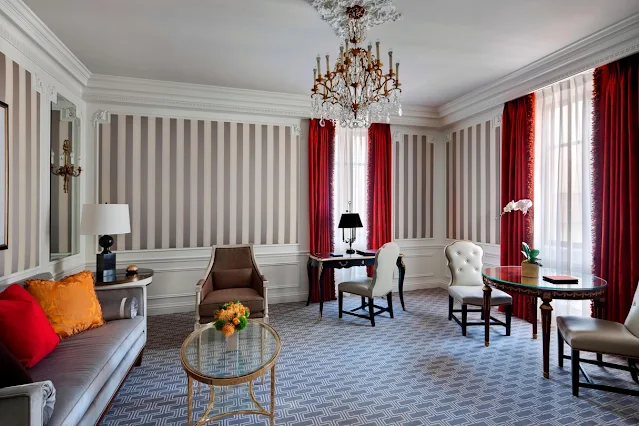Amanemu is a luxury resort located in Shima, Mie Prefecture, Japan. This serene retreat is nestled in the beautiful landscapes of the Ise-Shima National Park, offering guests an immersive experience in traditional Japanese culture and natural surroundings. Amanemu is part of the renowned Aman Resorts, known for their exceptional service and attention to detail. The resort was designed by Kerry Hill Architects, who aimed to create a harmonious blend of contemporary design and traditional Japanese aesthetics. The architecture and interior design of Amanemu draw inspiration from traditional Japanese ryokans, with minimalist yet elegant spaces that integrate seamlessly with the natural surroundings. Wood, natural stone, and traditional materials are prominent in the design, creating a calming and zen-like atmosphere. The resort features spacious suites and villas, each thoughtfully designed to provide every comfort and privacy. The interiors showcase a refined simplicity, with a focus on natural materials, clean lines, and a neutral color palette. Many of the accommodations also offer private hot spring bath facilities, allowing guests to indulge in the healing and relaxing experience of onsen (hot spring) bathing. In addition to its luxurious accommodations, Amanemu offers a range of amenities and experiences to enhance guests' stay. The resort has its own thermal hot spring-fed spa, offering a variety of wellness treatments and therapies inspired by traditional Japanese practices. Guests can also partake in activities such as hiking in the surrounding forests, exploring nearby shrines and temples, or simply enjoying the tranquility of the resort's beautiful gardens. Overall, Amanemu provides a tranquil and immersive retreat where guests can unwind, connect with nature, and experience the rich cultural heritage of Japan in a luxurious and serene setting.
TIME LINE
- September 2008 (2)
- December 2009 (1)
- January 2010 (1)
- March 2010 (2)
- January 2011 (13)
- February 2011 (6)
- March 2011 (3)
- April 2011 (6)
- May 2011 (2)
- June 2011 (20)
- July 2011 (72)
- August 2011 (35)
- September 2011 (10)
- October 2011 (73)
- November 2011 (11)
- December 2011 (6)
- January 2012 (6)
- February 2012 (1)
- March 2012 (5)
- April 2012 (1)
- May 2012 (2)
- June 2012 (3)
- July 2012 (5)
- December 2012 (1)
- July 2013 (1)
- August 2013 (1)
- September 2013 (1)
- November 2013 (1)
- February 2014 (1)
- April 2014 (1)
- May 2014 (3)
- July 2014 (1)
- August 2014 (1)
- October 2014 (1)
- May 2015 (1)
- August 2015 (1)
- November 2015 (2)
- January 2016 (1)
- February 2016 (2)
- March 2016 (3)
- May 2016 (2)
- July 2016 (1)
- September 2017 (1)
- March 2018 (1)
- May 2018 (1)
- August 2018 (1)
- January 2019 (1)
- May 2019 (1)
- September 2019 (1)
- February 2020 (1)
- April 2020 (2)
- July 2020 (1)
- September 2020 (2)
- October 2020 (1)
- November 2020 (1)
- February 2021 (3)
- April 2021 (3)
- May 2021 (11)
- June 2021 (4)
- July 2021 (3)
- August 2021 (1)
- September 2021 (1)
- October 2021 (4)
- January 2022 (1)
- May 2022 (9)
- August 2022 (1)
- September 2022 (1)
- October 2022 (2)
- December 2022 (1)
- February 2023 (2)
- March 2023 (6)
- April 2023 (10)
- May 2023 (18)
- June 2023 (40)
- July 2023 (86)
- August 2023 (21)
- September 2023 (14)
- October 2023 (39)
- November 2023 (25)
- December 2023 (18)
- January 2024 (15)
- February 2024 (12)
- March 2024 (4)
- April 2024 (9)
- May 2024 (17)
- June 2024 (18)
- July 2024 (21)
- August 2024 (28)
- September 2024 (17)
- October 2024 (17)
- November 2024 (22)
- December 2024 (17)
- January 2025 (9)
- February 2025 (9)
- March 2025 (13)
- April 2025 (10)
- May 2025 (11)
- June 2025 (6)
- July 2025 (22)
- August 2025 (3)
- September 2025 (8)
- October 2025 (8)
- November 2025 (9)
- December 2025 (2)
Monday, July 31, 2023
Amanemu Shima, Mie Prefecture, Japan
 Interior Designer: Life style - Comunity - Works
Mobile: (+84) 975675278
Email : tuannha.id@gmail.com
Interior Designer: Life style - Comunity - Works
Mobile: (+84) 975675278
Email : tuannha.id@gmail.com
The St. Regis New York
The St. Regis New York is a historic luxury hotel located in Manhattan, New York City. It has been a landmark in the city since its opening in 1904. The hotel is situated on Fifth Avenue, close to Central Park and many iconic New York City attractions. The St. Regis New York is known for its elegant and refined atmosphere, offering unparalleled luxury and personalized service to its guests. The hotel features luxurious accommodations, including rooms and suites that are tastefully decorated, blending classic elegance with modern amenities. The hotel also houses several exceptional dining options, including the Astor Court, a stylish restaurant serving contemporary cuisine, and the famous King Cole Bar, known for its signature cocktail, the Bloody Mary. The St. Regis New York offers a range of luxurious amenities, including a fitness center, a spa, and a 24-hour concierge service to cater to the needs of its guests. With its rich history, timeless elegance, and commitment to providing an exceptional experience, The St. Regis New York remains a top choice for discerning travelers seeking luxury and sophistication in the heart of Manhattan.
 Interior Designer: Life style - Comunity - Works
Mobile: (+84) 975675278
Email : tuannha.id@gmail.com
Interior Designer: Life style - Comunity - Works
Mobile: (+84) 975675278
Email : tuannha.id@gmail.com























































.jpg)
















.jpeg)
.jpg)




.jpeg)














